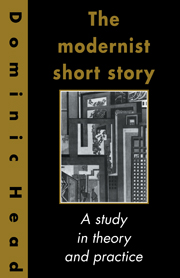Book contents
- Frontmatter
- Contents
- Preface
- Acknowledgements
- 1 The short story: theories and definitions
- 2 James Joyce: the non-epiphany principle
- 3 Virginia Woolf: experiments in genre
- 4 Katherine Mansfield: the impersonal short story
- 5 Wyndham Lewis: the Vorticist short story
- 6 Malcolm Lowry: expanding circles
- 7 Conclusion: contemporary issues
- Notes
- Bibliography
- Index
6 - Malcolm Lowry: expanding circles
Published online by Cambridge University Press: 06 July 2010
- Frontmatter
- Contents
- Preface
- Acknowledgements
- 1 The short story: theories and definitions
- 2 James Joyce: the non-epiphany principle
- 3 Virginia Woolf: experiments in genre
- 4 Katherine Mansfield: the impersonal short story
- 5 Wyndham Lewis: the Vorticist short story
- 6 Malcolm Lowry: expanding circles
- 7 Conclusion: contemporary issues
- Notes
- Bibliography
- Index
Summary
If literary Vorticism is an effective cul-de-sac in modernist fiction, with The Wild Body representing a stage of impasse for the short story, a different way of examining individual experience in the genre, and a way out of the impasse, is suggested in the stories of Malcolm Lowry, a writer whose work, with its heightened self-consciousness, also bridges the perceived gap between modernism and postmodernism.
The circularity of individual experience encompassed by one branch of modernism – typified in the Vorticism of Wyndham Lewis – is reversed in Lowry and rendered in an expansive, positive manner. The texts discussed so far are all obviously located in the historical period (1900–30) usually associated with modernism in literature, while Lowry wrote his major work in the 1940s and 1950s. Yet, as Malcolm Bradbury has pointed out, Lowry takes some of his ‘attitudes, colouring, and artistic assumptions from the climate of the 1930s, when the internationalist and experimental aspects of modernism survived … and had a direct continuity with the great modernists of the previous two or three decades’. An important aspect of this continuing tradition is its stress on ‘technical expertise and ostentation’, a literary self-consciousness which is pronounced in Lowry and which anticipates the overt metafictional style of much postmodern fiction: his stories offer a bridge between the experimental short story of the early twentieth century and the continuing relevance of the genre, a topic examined in the concluding chapter.
- Type
- Chapter
- Information
- The Modernist Short StoryA Study in Theory and Practice, pp. 165 - 184Publisher: Cambridge University PressPrint publication year: 1992



